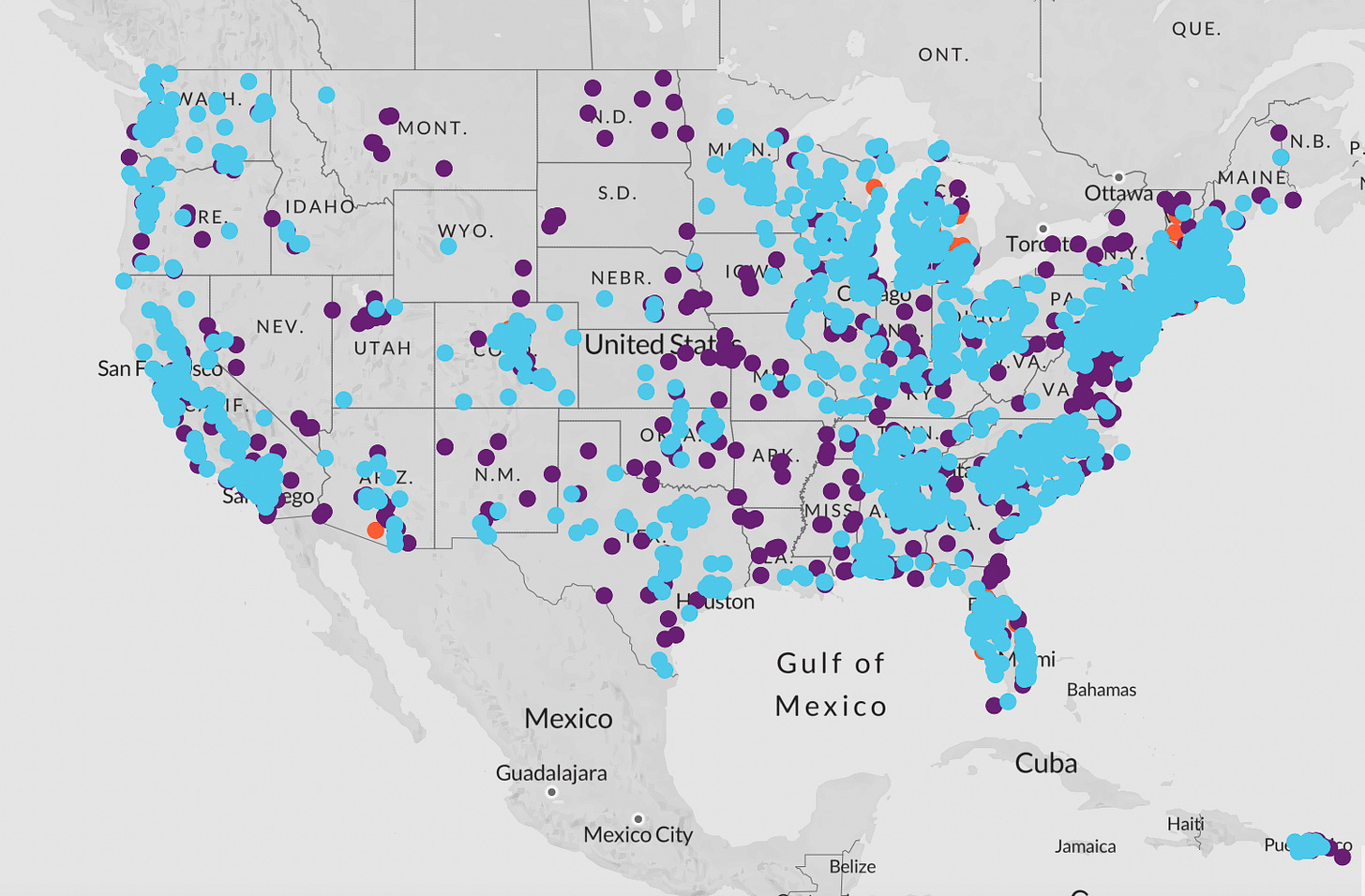MAGA's scariest environmental proposal
The blueprint for Trump’s second term envisions deregulating ubiquitous and carcinogenic “forever” chemicals.
This story is part of HEATED’s series on Project 2025. To learn more, check out our series announcement.

Diane Cotter is a proud “firewife”: the wife and mother of firefighters. On a phone call last week, she told me she’s “very much afraid” for her family and firefighting community, because of a little-known environmental proposal in Project 2025.
In the Heritage Foundation’s 900-page blueprint for Donald Trump’s second term, there’s a brief proposal to potentially deregulate a class of toxic chemicals called PFAS, found in firefighting foam and gear and linked to high rates of cancer among firefighters nationwide. Written by former members of Trump’s administration, it says the Environmental Protection Agency should “revisit the designation of PFAS chemicals as ‘hazardous substances’.”
The PFAS section does not specifically say how it will revise the EPA’s protections against the chemicals. But further in the document, Trump’s former EPA chief of staff reveals a vision to eliminate toxic chemical regulation of all kinds, to save “billions in economic costs” for the chemical industry.
It’s “just absolute bullshit,” Diane said of the proposal, and told me about the hell she believes PFAS has put her family and community through. Her husband Paul Cotter was diagnosed with prostate cancer in 2014, shortly after making lieutenant after 28 years at his firehouse in Worcester, Massachusetts.
“In Worcester alone, Paul's got a list of 50 of the guys that he's worked with and they have cancer,” said Diane, whose experience led her to become one of the most prominent PFAS activists in the country. “It just destroyed us …. All you think of is a death sentence.”
Paul survived his cancer, but complications from his life-saving surgery ended his career for good. He soon slipped into a depression so deep he couldn’t speak, Diane recalled. “I just couldn't recognize my husband anymore,” she said.
Diane links Paul’s cancer to PFOA—one of the most common types of PFAS chemicals and a known carcinogen—because of its ubiquitous presence in protective “turnout” gear. One night, she pulled out Paul’s 10-year old suit, and found small pieces of fabric missing from the crotch area. “The skin is so much more absorbent when a firefighter is sweating,” she recalled. “It took a nanosecond for me to click in and think, did Paul's gear degrade in the groin and that went right into his reproductive organs?” Diane sent samples to a physics professor at the University of Notre Dame; he found so much PFAS that he described the samples as “off the scale in parts per million of fluorine.”
Doctors were never able to confirm precisely what caused Paul’s cancer. But multiple peer-reviewed studies have linked PFAS and other chemical exposure to increased cancer risk among firefighters. And research has also confirmed that firefighting gear releases more PFAS the longer it’s worn.
If PFAS chemicals are deregulated as Project 2025 envisions, firefighters won’t be the only ones at risk. Because of the pervasive nature of these toxic chemicals in household goods, food, and drinking water around the country, advocates and academics tell me that this is among the most harmful environmental proposals of Project 2025.
“It just is really shocking,” said Scott Faber, vice president of government affairs at the nonprofit Environmental Working Group, which tracks PFAS contamination across the country. “It’s hard to imagine a more irresponsible act.”
“Doing the bidding of polluters”
PFAS—the abbreviation for per- and polyfluoroalkyl substances—are a large, complex group of synthetic chemicals found in everything from nonstick pans to stain-resistant carpets, cosmetics, microwavable popcorn, and firefighting foam. They’re commonly known as “forever” chemicals because the vast majority don’t break down: Once they’re released, they remain in the environment and human body forever.
The vast majority of PFAS forever chemicals—which include more than 12,000 chemical compounds—remain unregulated, untracked, and poorly understood. But one thing health experts do know is that exposure to even very small amounts of common PFAS chemicals are incredibly harmful, leading to cancer, reproductive issues, birth defects, immune system disorders, thyroid and other diseases.
That’s why this year, the Biden administration began regulating PFAS in the nation’s drinking water supply—the first time in more than 30 years that the Environmental Protection Agency has made a new rule for drinking water. The testing has so far revealed that more than 1,000 drinking water systems have PFAS levels above the safe limits set by the EPA, affecting more than 100 million Americans. Among them are thousands of civilian and military firefighters and their families, who are the most likely to be exposed to high levels via firefighting foam and their protective suits, called turnout gear.

The chemical industry, however, finds these regulations costly and burdensome—which is one reason why Project 2025 proposes to revisit them. Along with revisiting the designation of PFAS as hazardous, the document proposes to “revise groundwater cleanup regulations and policies to reflect the challenges of omnipresent contaminants like PFAS.” This would save “billions in economic costs,” the document says.
Mandy Gunesakara, Trump’s former EPA chief of staff, also argues that the current safe limit of PFAS set by the EPA is not based in sound science. Currently, the EPA’s recommended safe levels for six PFAS compounds range from 4 parts per trillion to 10 parts per trillion—though some scientific studies recommend a lower limit of only 1 part per trillion.
“The current designation was the result of a politicized, outcome driven process that has preceded completion of key scientific assessments, such as a clear understanding of PFAS impact on human health,” said a spokesperson for Project 2025 in an email. “The recommendation from Project 2025 would be to complete that process and then make a decision based on complete, unadulterated information.”
But scientists I spoke to for this story strongly disagreed with Project 2025’s assessment.
“This really has been a long time coming,” said Scott Bartell, professor of public health at the University of California, Irvine about the EPA’s drinking water standard. “There's been a lot of scientific evidence over the last decades demonstrating the variety of toxic impacts of PFAS exposure.”
Bartell, who has spent the last 25 years studying PFAS in drinking water and its health effects, said that other scientific organizations outside the EPA have come to the same conclusion.
“PFOA, one of the most notoriously widely used PFAS chemicals, is a known carcinogen and does cause cancer in humans. And PFOS is a possible carcinogen,” he said. “This is not a radical statement.”
Indeed, the EPA’s PFAS standards are based on decades of research that link forever chemicals to debilitating or deadly diseases. And the first people to know about the dangers of PFAS were the chemical companies themselves, who knew as early as 1970 that the chemicals were “highly toxic when inhaled and moderately toxic when ingested.” Despite this knowledge, chemical giants like 3M and DuPont continued to sell PFAS-riddled products, and disposed of the chemicals by burying them, burning them, or dumping them in waterways across the U.S.

Since then, thousands of people across the country, including military service members, firefighters, and citizens have launched lawsuits against PFAS manufacturers. 3M paid $10.3 billion to settle lawsuits over contaminated drinking water; DuPont paid more than $1.2 billion; Tyco Fire Products, the makers of firefighting foam, settled for $750 million. Altogether, the chemical industry has paid $11 billion to cover the costs of cleaning up ground and water contamination. But so far, no individuals—including the Cotters—have been compensated for the potential effects of exposure to carcinogenic PFAS chemicals.
“If adopted, the Project 2025 approach will result in large numbers of Americans getting cancer and other devastating illnesses,” said Judith Enck, president of the nonprofit Beyond Plastics and a former EPA regional administrator. “It is clear that the authors of Project 2025 do not understand science and are doing the bidding of polluters.”
Small changes, huge impact
Loosening regulations on PFAS is just one part of a much larger Republican plan to overhaul the EPA and make its science subject to political scrutiny. But it's an example of a small change—given no more than two sentences in a 900-page document—that could have a massive impact on public health.
The problem of PFAS pollution may be even more widespread than previously reported, impacting 200 million Americans in all 50 states, according to an EWG analysis based on EPA data. The worst of that contamination is found on military bases, where federal testing found PFAS levels in groundwater exceeding 100,000 parts per trillion.
It’s also in the food chain, contaminating farmland and livestock through the municipal sewage the federal government encouraged farmers to use as fertilizer. “What worries me more is the food chain contamination,” said Bartell. “For most people who don't have PFAS in their water supply, food is the largest source of exposure.”
Deregulating PFAS could put many of those Americans at risk, particularly those on military bases. Because if forever chemicals are no longer considered toxic by the EPA, “The DOD is no longer legally required to clean up the plumes that are flowing from more than 600 DOD installations into defense communities,” said Faber. Changing that hazardous designation “would just postpone even further into the future the day when literally some of the most contaminated sites in the world will be cleaned up,” he said.
That could set back decades of work from activists and whistleblowers like Diane Cotter, who have fought to make people aware of the danger they could face from simply using a nonstick pan, or drinking their tap water. It’s a particularly scary prospect, because unlike a hurricane or a wildfire, the PFAS crisis is mostly invisible—impossible to see with the naked eye, only making itself known once the damage has been done.
So Diane is going to keep fighting for stronger regulations on PFAS, she tells me. Because though her husband Paul may have retired, her son Pauly now rides the same fire truck his father once did—still wearing turnout gear saturated with forever chemicals.
“It terrifies me,” she said. “I'm more terrified about him wearing the gear than I am about the job itself.”
If Project 2025’s proposals are made policy by the next conservative president, she said it would have “devastating effects” on the work of activists, scientists, and environmental groups that have worked for years to make incremental progress.
“We cannot afford to go back one step,” she said. “You can’t give up anything in this war.”

Further reading:
Harris administration would rein in toxic PFAS chemicals, advocates say. The Guardian, August 2024.
Last year, Harris’s running mate, the Minnesota governor, Tim Walz, signed bold legislation prohibiting the use of toxic PFAS across a range of common consumer goods from menstrual products to food packaging – a measure that is considered by public health advocates to be among the “strongest bans in the world”.
Trump appointees barred EPA staff from warning Senate about ‘forever chemical’ loophole. The Hill, April 2024.
EPA experts from the Toxics Release Inventory Program had recognized the problem nearly a year before — but found themselves talking to a brick wall built by the Trump administration, according to the internal correspondence.
The experts recalled trying to inform the Senate committee that the language they were incorporating would not likely lead to stricter PFAS release reporting. But these messages apparently never reached their intended recipients.
How 3M Executives Convinced a Scientist the Forever Chemicals She Found in Human Blood Were Safe. Propublica, May 2024.
Philippe Grandjean, a physician who helped discover that PFAS harm the immune system, believes that anyone exposed to these chemicals — essentially everyone — may have an elevated risk of cancer. Our immune systems often find and kill abnormal cells before they turn into tumors. “PFAS interfere with the immune system, and likely also this critical function,” he told me. Grandjean, who served as an expert witness in the Minnesota AG’s case, has studied many environmental contaminants, including mercury. The impact of PFAS was so much more extreme, he said, that one of his colleagues initially thought it was the result of nuclear radiation.
How US chemical industry lobbying and cash defeated regulation in Trump era. The Guardian, April 2021.
The seven largest PFAS producers and their industry trade groups tallied at least $61m in federal political spending during 2019 and 2020, the bulk of which was directed at lobbying Congress and the Trump administration instead of campaign donations. … finance records broadly show that industry focused on killing multiple proposals that could’ve forced them to cover the astronomical costs for cleaning up widespread PFAS pollution.
Catch of the day: Reader Donna shared her “furry heart monster”, Leroy Jethro. While he doesn’t solve crimes like his NCIS namesake, Leroy reminds her every day that a healthier and more joyful future is possible, if only we are brave enough to step into it.
Want to see your furry (or non-furry!) friend in HEATED? Send a picture and some words to catchoftheday@heated.world.



Thank you so much for the continued reporting on this and especially focusing on the fact that things with major ramifications can get a couple of lines of text in a massive document.
I don't understand how such an extreme policy agenda is getting so little coverage elsewhere, and if it does it is framed more like "Democrats attack Project 2025 and Trump distances himself from it" electoral race coverage, instead of actually just explaining what it is and how obviously it is what Trump and Republicans want to do, like here.
Don't have time to listen to the article but I'm positive it is great too! Thank you again Arielle!
Thank you for creating an audio version. For those of us with reading impairments it is greatly appreciated. It makes it so much easier to follow your great reporting.